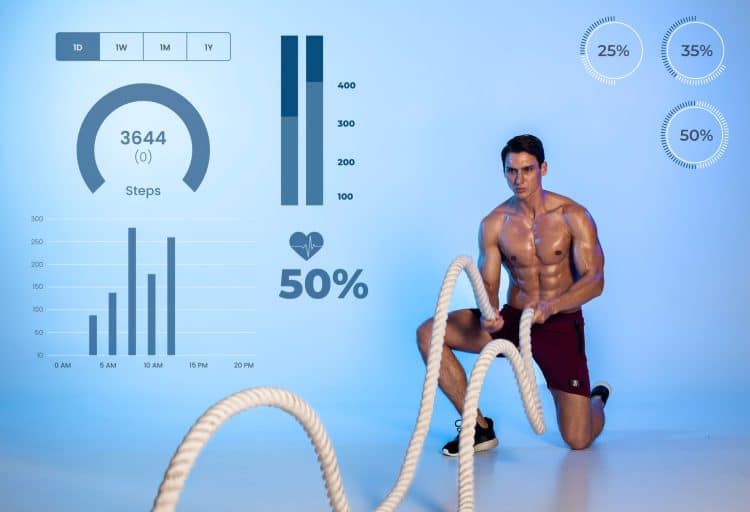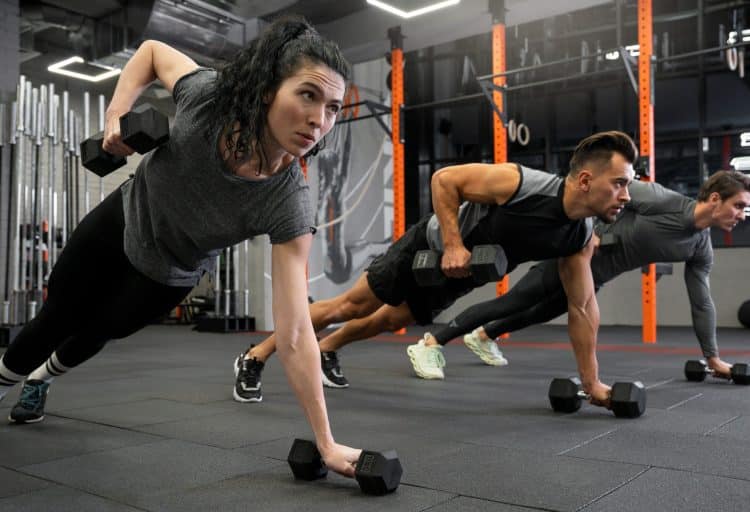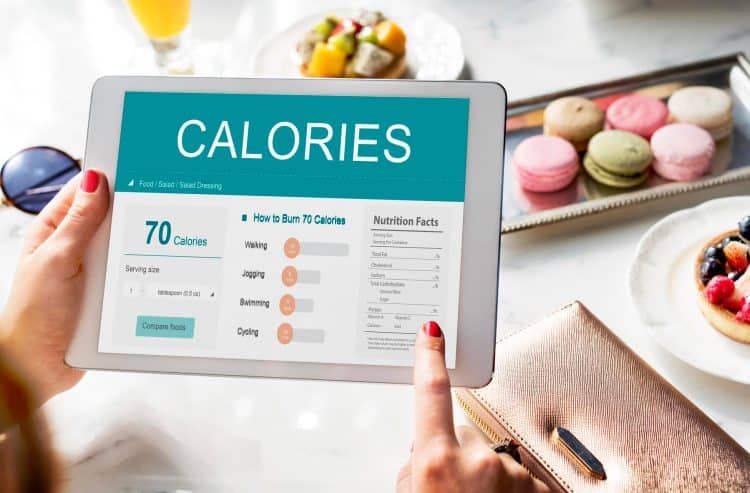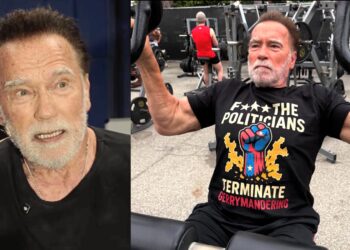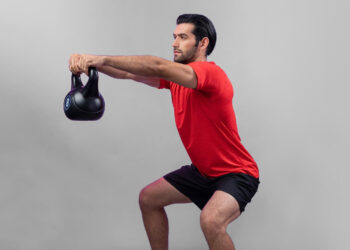As a 16-year gym veteran, if I got a dollar every time someone asked me, “How many calories should I burn a day to lose fat,” I’d be rolling in cash like a crypto millionaire with a flashy Lambo.
Most people join a gym to lose weight. However, a majority quit before achieving their weight loss objective.
A calorie deficit is the most crucial weight loss component and involves expending more calories in a day than you consume.
It doesn’t matter if you run a 10K every day. You will eventually gain weight if you eat more calories than you burn in a day and are in a caloric surplus. Maintenance calories are the number of calories your body needs to support energy expenditure and maintain your current body weight.
With the basics of calories out of the way, let’s address the elephant in the room — how many calories should you burn in a day to lose weight?
Adults typically require burning 1,600–2,200 calories (females) and 2,200–3,000 calories (males), varying with individual body needs, health metrics, activity levels, and lifestyle choices.
Level Up Your Fitness: Join our 💪 strong community in Fitness Volt Newsletter. Get daily inspiration, expert-backed workouts, nutrition tips, the latest in strength sports, and the support you need to reach your goals. Subscribe for free!
In this article, we dive into everything you need to know about burning calories and losing weight, including calculating basal metabolic rate, the role of exercise, estimating daily and weekly caloric needs, and tips for boosting your progress.
Understanding Calorie Burn
The process where your body converts what you eat and drink into energy is known as calorie burning. Your body then uses this energy to fuel your daily activities, from working out to internal processes vital for keeping you alive.
When you consume too many calories in the form of foods and drinks but don’t burn them through physical activity, the body stores the excess calories in the form of glycogen, known as body fat.
Once you start burning more calories than you ingest, your body uses the stored glycogen as fuel. Continue this for a long enough time, and you will get into the single-digit body fat percentage.
That said, following a balanced diet (with an adequate protein, carbs, and fat ratio) is non-negotiable while trying to lose weight. For example, eating low protein on a weight loss diet can put you in a catabolic state, where your body begins burning muscle for fuel.
Beginners should get help from personal trainers to ensure they are on the right path. It might cost some money upfront, but it will pay dividends in the long term and save a lot of time, money, and effort while significantly reducing injury risk.
Check out our complete list of calorie-burning calculators here.
Factors Affecting Weight Loss
No two people are built the same. You will have varying weight loss results even if you follow the same weight loss workout program as your training partner and eat the same amount of calories. Here are some of the factors that affect weight loss:
Age
Age has more than one effect on your weight loss journey. As people age, their metabolism tends to slow down, which hampers their calorie-burning process. Older folks must work harder to lose weight than their younger counterparts.
The natural loss of muscle mass and hormonal changes that occur with age are also detrimental to your weight loss ambitions.
Gender
Men generally have a higher muscle mass than women, allowing them to burn calories slightly faster. It’s like men are driving sports cars in calorie-burning, while women are in pick-up trucks — both get to the destination but at different speeds.
A study published in the British Journal of Nutrition found that men’s absolute resting metabolic rate (RMR) is higher than women’s. However, the difference becomes insignificant when RMR is adjusted for lean body mass (LBM). Therefore, while men generally have a higher metabolic rate, this difference is closely tied to differences in body composition, particularly LBM. (1)
Weight and Height
An individual’s weight and height also affect the amount of calories burned. A larger physique burns more calories (even at rest), as it requires more energy to function. That said, larger individuals tend to eat more to ensure optimal functionality.
Activity Level
Irrespective of how high your metabolic rate is, you cannot expect to lose weight by sitting on the couch all day long. The more active you are, the more calories you will burn.
That said, you don’t have to do too much too soon in hopes of losing weight. Find an activity that fits your experience level and lifestyle. From intense CrossFit sessions to a serene yoga flow, every movement counts.
Calculating Basal Metabolic Rate (BMR)
Understanding basal metabolic rate (BMR) gets you one step closer to meeting your fitness goal, whether it is losing weight or building muscle tissue by decoding how your body uses energy.
BMR represents the amount of energy your body requires to maintain basic physiological functions while at rest. This energy goes into vital processes like breathing, circulation, cell production, nutrient processing, and temperature regulation.
Knowing your BMR helps design a tailored diet and exercise plan that fits your unique energy requirements.
Calculating Your BMR: A Step-By-Step Guide
The Harris-Benedict Equation and the Mifflin-St Jeor Equation are the two most popular methods of calculating BMR. Each method considers factors like age, sex, weight, and height to estimate your daily calorie needs at rest.
1. The Harris-Benedict Equation
Men: 88.362 + (13.397 x weight in kg) + (4.799 x height in cm) – (5.677 x age in years)
Women: 447.593 + (9.247 x weight in kg) + (3.098 x height in cm) – (4.330 x age in years)
The Harris-Benedict equation is an older method but is widely used by fitness experts and in most popular fitness calculators.
Level Up Your Fitness: Join our 💪 strong community in Fitness Volt Newsletter. Get daily inspiration, expert-backed workouts, nutrition tips, the latest in strength sports, and the support you need to reach your goals. Subscribe for free!
2. The Mifflin-St Jeor Equation
Men: 10 x weight in kg + 6.25 x height in cm – 5 x age in years + 5
Women: 10 x weight in kg + 6.25 x height in cm – 5 x age in years – 161
This is a newer and slightly more accurate formula than the Harris-Benedict equation.
After determining your BMR, you can have a clearer picture of how many calories you need to set realistic and effective fitness goals, whether it is weight loss, muscle gain, or maintaining your current physique.
With that out of the way, doing the BMR calculations manually can get tedious, especially if you are a coach who has to do it for multiple clients each week. To this effect, you must use the Fitness Volt BMR calculator and guide to get the most reliable results.
The Role of Exercise in Calorie Burning
As a seasoned personal trainer with a deep understanding of fitness dynamics, I can attest that exercise is a critical component in the calorie-burning equation. Different types of exercises have varying calorie-burning effects. Here are some of the most effective exercises to shed the spare tire:
- High-Intensity Interval Training (HIIT): HIIT is arguably the most popular form of exercise amongst exercisers who join the gym to lose weight. It alternates between intense bursts of activity and fixed periods of less intense activity or complete rest. HIIT workouts are a time-efficient exercise that keeps your metabolic rate elevated.
- Running: There is a reason why a majority of professional runners are skinny. Running is one of the most effective calorie-burning forms of exercise. It engages multiple muscle groups and is apt for people of different ages, experiences, and fitness levels.
- Swimming: Swimming is a full-body, low-impact exercise perfect for people dealing with joint issues. That said, people coping with health conditions should get their doctor’s clearance before starting any training regimen.
- Boxing: This is an often overlooked form of exercise while trying to lose weight. It combines aerobic and anaerobic exercise, which helps melt fat off your body. Boxing also improves coordination and strength.
Total Daily Energy Expenditure (TDEE): How Many Calories Should I Burn?
Most people, including experienced personal trainers, are confused between TDEE and BMR. This section will help clear out the doubts for good.
TDEE is the total number of calories you burn in a day. It combines your BMR with physical activity.
To calculate your TDEE, determine your BMR and multiply the number by an activity factor (sedentary, lightly active, moderately active, very active, or extra active).
These calculations can be overwhelming, especially for folks who hate math. Use our TDEE calculator for the most accurate results.
Understanding your BMR is crucial, but combining it with TDEE is pivotal in crafting a fitness regime that aligns with your calorie-burning goals.
Feel free to seek a professional’s help if you need a second opinion about your BMR and TDEE calculations.
Estimating Daily and Weekly Calorie Needs
You can’t achieve your dream physique in a few hours or days; it takes multiple weeks. That said, you must do everything right on the micro level to ensure you’re moving in the right direction.
Your weight loss journey begins by understanding how many calories you must burn daily to enter a calorie deficit and achieve your weight loss goals.
Daily Calorie Estimation for Weight Loss
Here is a step-by-step guide for daily calorie estimation for weight loss:
- Calculate BMR: Use our BMR calculator to determine your basal metabolic rate.
- Activity Level Adjustment: After determining your BMR, adjust it based on your activity level and TDEE.
- Create a Calorie Deficit: To lose weight, you must enter a calorie deficit. According to the Centers for Disease Control and Prevention (CDC), an individual must cut 500 calories from their daily calorie intake to shed 1 pound a week safely and sustainably. (2)
Translating to Weekly Goals
Converting your daily calorie needs into weekly goals adds perspective and allows for flexibility. A 500 daily calorie cut translates to a weekly deficit of 3,500 calories, equating to about 1 pound of weight loss per week.
Having a weekly calorie deficit in perspective allows you to accommodate an unplanned cheat meal into your regimen. You can compensate for the excess calories by deducting a few extra calories from the upcoming days.
Pro Tip: Don’t follow a random calorie deficit. Daily calorie needs can fluctuate based on various factors like stress, sleep, and hormonal changes. Find a calorie deficit that works for you.
Diet and Calorie Burn
Your diet and the foods you eat can play a significant role in your calorie-burning ambitions. The foods you eat can significantly influence your metabolism. Here are some of the foods that should be a part of your weight-loss diet:
- Protein-Rich Foods: Chicken, fish, tofu, beans, and lentils require more energy for digestion, increasing calorie burn. This process is known as the thermic effect of food (TEF). Therefore, eating protein supports muscle repair and growth and increases calorie expenditure.
- Spicy Foods: Ingredients like chili peppers contain capsaicin, which can boost metabolism and calorie burn. Adding a little spice to your meals can lead to a metabolism-boosting effect.
- Green Tea and Coffee: These beverages are popular for their metabolism-boosting properties. The caffeine in coffee and the catechins in green tea boost calorie burning and are excellent for burning body fat. (3)
- Whole Grains: Foods like brown rice, oatmeal, and quinoa require more energy to break down, boosting fat loss. This is also why most nutritionists emphasize adding whole grains to your diet.
Tips for Increasing Calorie Burn
Here are some practical tips to enhance calorie burning:
- Incorporate HIIT into Your Workout Regimen: HIIT workouts burn a lot of calories and spike your metabolism. Plus, your metabolic rate stays elevated for several hours post-workout, which helps you burn more calories throughout the day.
- Strength Training is Crucial: Strength training builds muscle, which helps burn more calories, even at rest. Weight training and even strength training routines can significantly boost your BMR.
- Switch Up Your Training Intensity: Avoiding monotonous training routines and spicing things up with different training intensities and styles keeps your body guessing, which leads to increased calorie burn.
- Stay Active Outside the Gym: Making smarter decisions like taking the stairs instead of the elevator, walking during breaks and phone calls, and biking to work can boost your total calorie burn rate.
Understanding how your body uses energy, how it responds to different types of exercises, and how you can create a sustainable, healthy lifestyle is the most effective way of increasing calorie burn and achieving your weight loss goals.
Overcoming Common Misconceptions
In this world of instant solutions and quick fixes, it’s easy to get lost in the myriad of ‘secret formulas’ and ‘magic numbers’ that promise rapid weight loss.
Every time you encounter a weight loss hack that is too good to be true, chances are that your gut instinct is probably right, and you’re being gaslighted into a fad.
These are some common myths and misunderstandings related to calorie burn and weight loss:
- Lower Intensity Exercise Burns More Fat: Most people engage in LISS (low-intensity steady state) cardio as they believe slower and longer cardio sessions are more effective for weight loss. However, HIIT burns more calories overall, making it more beneficial for weight loss. (4)
- You Can Spot Reduce Fat: This is a myth that refuses to die. Fat loss occurs uniformly throughout the body, depending on genetics, diet, and overall exercise, rather than in specific targeted spots.
- More Gym Time Always Equals More Weight Loss: Quality often trumps quantity when it comes to training. Conversely, overtraining or reckless workouts can increase your risk of injury, which can potentially derail your transformation objectives.
Conclusion
Most people can never achieve their weight loss goals as they follow vanilla weight loss programs they find on the internet. This ‘how many calories should I burn a day’ guide pulls back the curtain on everything you need to know to run a calorie deficit and the importance of following a customized diet plan to achieve your training objectives.
There is no one answer to how many calories you should burn daily. It will depend on your current physical state, lifestyle, and training objective. Creating a manageable calorie deficit is key to achieving your weight loss goals.
If you have any doubts or queries about running a calorie deficit, leave them in the comments below, and I’ll be happy to help!
References
- Buchholz AC, Rafii M, Pencharz PB. Is resting metabolic rate different between men and women? Br J Nutr. 2001 Dec;86(6):641-6. doi: 10.1079/bjn2001471. PMID: 11749674.
- Centers for Disease Control and Prevention. Burn More Calories Than You Take In. [Internet]. [cited 2023 Dec 15]. Available from: https://www.cdc.gov/diabetes/prevention/pdf/t2/Participant-Module-7_Burn_More_Calories_Than_You_Take_In.pdf
- Hursel R, Viechtbauer W, Westerterp-Plantenga MS. The effects of green tea on weight loss and weight maintenance: a meta-analysis. Int J Obes (Lond). 2009 Sep;33(9):956-61. doi: 10.1038/ijo.2009.135. Epub 2009 Jul 14. PMID: 19597519.
- Kolnes KJ, Petersen MH, Lien-Iversen T, Højlund K, Jensen J. Effect of Exercise Training on Fat Loss-Energetic Perspectives and the Role of Improved Adipose Tissue Function and Body Fat Distribution. Front Physiol. 2021;12:737709. Published 2021 Sep 24. doi:10.3389/fphys.2021.737709

